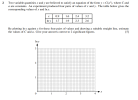-
We need your support!
We are currently struggling to cover the operational costs of Xtremepapers, as a result we might have to shut this website down. Please donate if we have helped you and help make a difference in other students' lives!
Click here to Donate Now (View Announcement)
You are using an out of date browser. It may not display this or other websites correctly.
You should upgrade or use an alternative browser.
You should upgrade or use an alternative browser.
CAIE pure math P2&3 Logarithmic and Exponential Functions question
- Thread starter Tony2023
- Start date
- Messages
- 20
- Reaction score
- 7
- Points
- 13
[imath]\rightarrow y = C(a^x)[/imath]
[imath]\rightarrow ln(y) = ln(c) + xln(a)[/imath]
[imath]\rightarrow ln(y) = ln(a)x + ln(c)[/imath]
[imath]\implies gradient = ln(a)[/imath]
[imath]\implies y-intercept = ln(c)[/imath]
[imath]\rarr[/imath] You can now sketch the graph and find what's the gradient and y-intercept.
[imath]rarr[/imath] Then use the above two equations for gradient and y-intercept to find the values of a and c respectively.
[imath]\rightarrow ln(y) = ln(c) + xln(a)[/imath]
[imath]\rightarrow ln(y) = ln(a)x + ln(c)[/imath]
[imath]\implies gradient = ln(a)[/imath]
[imath]\implies y-intercept = ln(c)[/imath]
[imath]\rarr[/imath] You can now sketch the graph and find what's the gradient and y-intercept.
[imath]rarr[/imath] Then use the above two equations for gradient and y-intercept to find the values of a and c respectively.
I have used your idea to done. But I calculate the gradient is 0.39? Is right?[imath]\rightarrow y = C(a^x)[/imath]
[imath]\rightarrow ln(y) = ln(c) + xln(a)[/imath]
[imath]\rightarrow ln(y) = ln(a)x + ln(c)[/imath]
[imath]\implies gradient = ln(a)[/imath]
[imath]\implies y-intercept = ln(c)[/imath]
[imath]\rarr[/imath] You can now sketch the graph and find what's the gradient and y-intercept.
[imath]rarr[/imath] Then use the above two equations for gradient and y-intercept to find the values of a and c respectively.
- Messages
- 20
- Reaction score
- 7
- Points
- 13
For that, you will have to sketch the graph and take points at least more than half the graph to find the gradient.I have used your idea to done. But I calculate the gradient is 0.39? Is right?
OK, thanks.For that, you will have to sketch the graph and take points at least more than half the graph to find the gradient.

